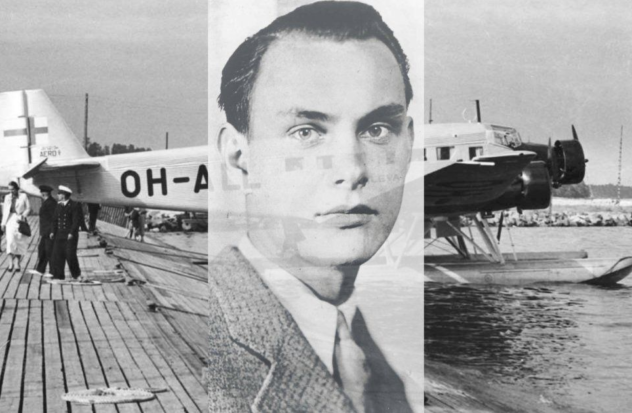It was demolished a few days before Moscow annexed the Baltic States. All nine people aboard the aircraft were killed: Two Finnish crew members and seven passengers—one American diplomat, two Frenchmen, two Germans, one Swede, and one dual Estonian-Finnish citizen.
A diving and rescue team in Estonia reported this week that it had located well-preserved pieces and remains of the plane Junkers Ju 52 operated by the Finnish airline Aero—now Finnair. It was found off the small island of Keri, near Tallinn, the capital of Estonia, at a depth of about 70 meters (230 feet).
“We basically started from scratch. We took a completely different approach to the search,” Kaido Peremees, spokesperson for the Estonian diving and underwater survey company Tuukritoode OU, explained about the group’s achievement in exploring to find the wreckage of the plane.
The downing of the civilian plane, called Kaleva, en route from Tallinn to Helsinki, occurred on June 14, 1940, just three months after Finland signed a peace treaty with Moscow after the Winter War of 1939-1940.
The news about the fate of the plane was received with disbelief and anger by the Helsinki authorities, who were informed that it was shot down by two Soviet DB-3 bombers 10 minutes after taking off from Ulemiste airport in Tallinn.
Finland officially remained silent for years about the details of the plane’s destruction, publicly only saying that a “mysterious accident” had occurred over the Baltic Sea because it did not want to provoke Moscow.
Although well documented by books, investigations and television documentaries, the 84-year-old mystery has intrigued Finns. The case is an essential part of the Nordic country’s complex World War II history, and sheds light on its troubled ties with Moscow. But perhaps most importantly, the downing of the plane occurred at a critical moment, just days before Josef Stalin’s Soviet Union prepared to annex the three Baltic states and seal the fate of Estonia, Latvia and Lithuania for the next half century. before they finally regained their independence in 1991.
Moscow occupied Estonia on June 17, 1940, and the doomed Kaleva flight was the last from Tallinn—although the Soviets had already begun imposing a strict transportation embargo around the Estonian capital.
The diplomat who was on the Junkers plane
The American diplomat Henry W. Antheil Jr.who is now considered one of the first American casualties of World War II, was aboard the plane when it was shot down.
Antheil, 27, younger brother of acclaimed composer and pianist George Antheil, was on a hurried government mission to evacuate confidential diplomatic bags from the American missions in Tallinn and Riga, Latvia, when it became clear that Moscow was preparing to annex the small Baltic nations.
A telegraphic article from The Associated Press dated June 15, 1940 noted that “Henry W. Antheil Jr., of Trenton, New Jersey, attached to the United States consulate in Helsinki, died yesterday in the mysterious explosion of a Finnish airliner. passengers.” In the American media, Antheil’s death was overshadowed by a much bigger story coming out of Europe at the time: The Nazi occupation of Paris.
The US Embassy in Tallinn has thoroughly documented and investigated the case over the years.
Embassy spokesman Mike Snyder told the AP that “news of the possible location of the wreckage of the Kaleva airliner is of great interest to the United States, especially as one of the first American casualties of World War II , that of diplomat Henry Antheil, occurred as a result of the downing of the plane.”
Earlier this month, U.S. Ambassador to Estonia George P. Kent shared an engraved on it.
The Kaleva was carrying 227 kilograms (500 pounds) of diplomatic mail, including Antheil’s suitcases and material from two French diplomatic couriers identified as Paul Longuet and Frederic Marty.
Estonian fishermen and the operator of the lighthouse in Keri told Finnish media decades after the plane was shot down that a Soviet submarine surfaced near where the Kaleva went down and recovered floating debris, including bags of documents that local fishermen had collected.
This has given rise to conspiracy theories about the contents of the suitcases and Moscow’s decision to shoot down the plane. It is still unclear why the Soviet Union decided to shoot down a Finnish civilian airliner in peacetime.
“A lot of speculation about the plane’s cargo has been heard over the years,” Geust said. “What was the plane carrying? Many suggest that Moscow wanted to prevent confidential material and documents from leaving Estonia.”
But he added that it could have just been “a mistake” by the Soviet bomber pilots.
Several attempts to find the Kaleva had been recorded since Estonia regained its independence more than three decades ago. However, none of them had been successful.
Not even the US Navy’s Pathfinder oceanographic survey ship was able to locate the wreckage of the plane in a search carried out in 2008 around Keri Island, in a task commissioned by the Estonian government to the Pentagon.
“The wreckage of the plane is in pieces and the seabed is quite challenging — with rock formations, valleys and hills. It’s very easy to miss” the small parts and debris on the plane, Peremees explained.
“Of course, techniques have evolved a lot over time. As always, you can have good technology, but not be lucky,” he noted.
A new video recorded by robotic submersibles from Peremees’ company shows clear images of the Junkers trimotor landing gear, one of the engines and parts of the wings.
Peremees and his group are “absolutely” convinced that the pieces belong to the Kaleva due to the distinctive and recognizable design of the German-made Junkers Ju 52, one of the most popular European passenger transport and war planes in the 1930s and early 1940s.
The plane was operated by the predecessor of the Finnish national airline, Finnair.
Jaakko Schildt, Finnair’s chief operating officer, described the downing of the Kaleva as “a tragic and deeply sad event for the young airline” that was Finnair – then called Aero – in 1940.
“Finding the wreckage of the Kaleva somewhat closes the episode, although it does not recover the lives of our customers and crew who were lost,” Schildt added. “The interest in locating the Kaleva in the Baltic Sea speaks to the importance of this tragic event in the history of aviation in our region.”
Peremees said his company will now focus on creating 3D images of the Kaleva debris and will discuss with Estonian authorities the possibility of recovering some of the items, and, if found, the plane’s cargo and human remains.
Snyder, of the U.S. Embassy in Tallinn, said Washington is closely monitoring the diving group’s efforts.
“We are continuing the investigation on site and will be happy to discuss with our Finnish and Estonian (NATO) allies any developments resulting from the recovery efforts,” Snyder announced.
A stone monument was erected in Keri in the early 1990s in honor of the victims of the Kaleva incident, and the preserved former terminal building of Helsinki’s Malmi Airport, where Kaleva was supposed to arrive, has a plaque memorial placed in 2020 with the names of the victims.
Source: AP





